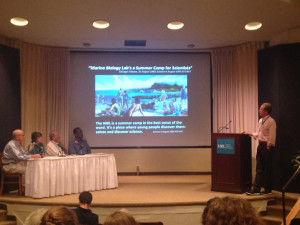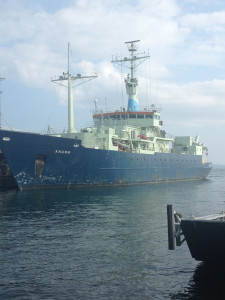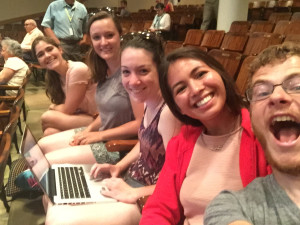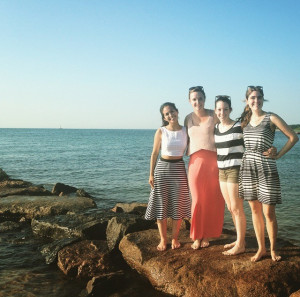Friday afternoon, and five marsh-logged REUs eagerly stuffed clothes into bags, piled into cars and headed south. After a long week, we were more than ready for time off. Three hours later, after driving like salmon through Boston traffic, we arrived at the Cape and hit the town for some shopping and seafood. Our rag-tag group was prepping for what promised to be a wild weekend. But by wild, I mean there were a lot of people. And by people I mean scientists. And by scientists, I mean the speakers and attendees for the Celebrating Discovery conference at the Marine Biological Laboratory of Woods Hole.

Woods Hole, MA has an international reputation as the hub for marine science research. Along a half-kilometer long road, the Marine Biological Laboratory (MBL), Woods Hole Oceanographic Institute (WHOI), and the National Oceanic and Atmospheric Administration (NOAA) all have prestigious research facilities. A mere five-minute walk and I could have caught flies – my jaw dropped, and never have I felt like such a kid in a candy shop. Within the greater Woods Hole area, the United States Geological Survey, the National Academy of Sciences, and Semester at Sea also have facilities.
The coastline is peppered with hulking research vessels, docked for the summertime. Quaint coffee shops and restaurants attract tourists and scientists alike, where it is not uncommon to overhear sincere discussions about the future of bioinformatics. I was thrilled to be in an area associated with such prestige and history (MBL has produced over 50 Nobel laureates), and even more awe-struck that I somehow fit into the giant cog of this machine.

The Celebrating Discovery conference took the form of “plenary sessions”, meaning a series of speakers would give talks within the same general topic. Speakers from UC Berkeley, WHOI, Harvard, Duke University, Brown, Dartmouth, the Amazon Environmental Research Institute, Argonne Laboratories, the Smithsonian, Howard Hughes Medical Institute and more, presented on everything from eco-evolutionary biology to computational modeling and medical breakthroughs in tissue regeneration. MBL is officially affiliated with Brown University and the University of Chicago, and collaborates with other universities and laboratories across the world. By simply walking into the auditorium for a lecture, you felt smarter. Some of the most brilliant minds in the marine sciences were in the room. While the weekend may not have been “wild” by Cape Cod’s standards, it was an intellectually stimulating and highly social event.
Scientists are often portrayed as socially awkward, brooding, and plain weird; in the digital age of professional-networking platforms (e.g LinkedIn and ResearchGate) and email-related frenzy, it would be more than easy for scientists to entirely block out physical connection with the outside world. Publications are the primary way that the scientific community connects with one another. Yet, it is during conferences that we make the most interdisciplinary connections. Conferences provide dedicated venues and forums for scientists of all specialties to meet and learn from one another. The standing joke is that MBL is a summer camp for scientists, as we much prefer sitting on beaches in deep conversation than locked away in a cold dark basement lab. (Beach time was existent but unfortunately minimal). By the end of the weekend, each of us had further honed our interests and met someone who was driving scientific inquiry in their field. It opened our eyes to the deeply collaborative nature of the MBL, and showed that despite the name, MBL does not restrict its limitless ideas to the seas.

MBL’s remarkable collaboration with numerous institutions is further highlighted in its equal success in communicating its research. While conferences are wonderful places for scientists to share new ideas, it is meaningless unless conveyed to policy-makers, medical experts, and the general public. As one example, MBL sponsors Friday evening lectures throughout the summer that draw crowds to fill two auditoriums, with internationally known speakers. The lecture is followed by a beautiful reception, where people of all backgrounds can mingle. Local outreach is equally as important; non-scientific residents can appreciate the importance of those hulking research vessels that block their view of the ocean. Our own blog gives the TIDE project a digital presence to communicate to public the imperative nature of our own work, and even attract future researchers. (It also provides excellent writing practice for the interns – that’s me!)
When communication of new ideas and questions is effective, it can change the people’s perception of environmental problems. Communication comes in a plethora of forms, from books that start a green revolution, to 140 character tweets. We cannot keep our ideas to ourselves; science is worth nothing if no one else knows. MBL’s weekend of discovery was about asking relevant scientific questions to reach novel intellectual destinations and foster a diverse intellectual community. The depth and breadth of researchers that are attracted to Woods Hole is already staggering, but the MBL is pushing the frontier of discovery.
If ideas are truly the currency of the 21st century, then these giddy summer-campers struck gold.

Nathalie Moore is a rising junior at the College of William and Mary. She is a double major in Biology and Environmental Science, and her summer research for the MBL focuses on salt marsh creek bank degradation and foraging success of a top predator, F. heteroclitus. She will be presenting her work on Austral invasion and fire ecology at the 100th Meeting of the Ecological Society of America in Baltimore, MD on August 13th.
Leave a Reply